File:Christchurch and Waihora, 2001, Landsat 7 ETM (cropped).jpg

Original file (1,467 × 1,482 pixels, file size: 854 KB, MIME type: image/jpeg)
| This is a file from the Wikimedia Commons. Information from its description page there is shown below. Commons is a freely licensed media file repository. You can help. |
Summary
| DescriptionChristchurch and Waihora, 2001, Landsat 7 ETM (cropped).jpg |
English: This satellite image shows Banks Peninsula, including Lyttelton Harbour and Akaroa Harbour, and the city of Christchurch, in Canterbury, New Zealand.
Original caption: Christchurch City (population 320,000) sits at the base of the long arc of Pegasus Bay, bounded to the north by the Waimakariri River and to the south by the old crater complex of the Port Hills and Banks Peninsula. The heavily braided rivers of the South Island of New Zealand bring greywacke rock from the Southern Alps to the west, forming the huge alluvial pan (750,000 ha) of the Canterbury Plains. Braided rivers are rare worldwide, found elsewhere only in Alaska, Canada, and the Himalayas. They form a network of ever-changing channels weaving between temporary shingle islands. In some places, the gravel they have transported from the mountains formed by the clash of the Indo-Australian and Pacific Plates is as much as 500 meters deep. Banks Peninsula, named for explorer Captain Cook’s botanist, consists of two overlapping extinct volcanoes, the Lyttelton Volcano and the Akaroa Volcano. Since the last eruptive activity some six million years ago, the volcanoes have been heavily eroded, dropping them from a peak of 1,500 meters down to around 500 meters. During his quick 1770 visit, Cook mistook the peninsula for an island, but the build up of the Canterbury Plains has seen it joined to the mainland for at least 200,000 years. Breaches in the crater walls have produced two long harbors: Lyttelton to the north and Akaroa to the south. The former is the port for Christchurch, and European settlers in the 1860s were quick to bore a tunnel through to Christchurch rather than tackle the steep hills and long swampy walk into the early settlement. The original idea was to settle at the end of Lyttelton Harbour, but the huge mudflats exposed at low tide put paid to that plan. The shallow green waters of Lake Ellesmere (Waihora) to the south of the city offer a refuge for wildlife. The estuary for the small Avon and Heathcote rivers, just to the north of Lyttelton Harbour, is home to godwits, curlews and other visitors from Siberia and Alaska, as Asian and American birds reach the southernmost point of their annual migrations here. This image was acquired by the Enhanced Thematic Mapper plus (ETM+) sensor flying aboard the Landsat 7 satellite on September 25, 2001. |
|||
| Date | (data acquired), 2003-02-17 (published) | |||
| Source | Image here, with description here | |||
| Author | NASA's Earth Observatory. Their caption is by Vicki Hyde, managing editor of the SciTech Daily Review. Image by Jesse Allen, based on data provided by the Landsat 7 Science Team. | |||
| Other versions |
|
Licensing
| Public domainPublic domainfalsefalse |
| This file is in the public domain in the United States because it was solely created by NASA. NASA copyright policy states that "NASA material is not protected by copyright unless noted". (See Template:PD-USGov, NASA copyright policy page or JPL Image Use Policy.) |  | |
 |
Warnings:
|
| Annotations InfoField | This image is annotated: View the annotations at Commons |
Kaitorete Spit
Captions
Items portrayed in this file
depicts
25 September 2001
image/jpeg
c54c4f51d2ffef183cf86be353fb37f41fc68154
874,332 byte
1,482 pixel
1,467 pixel
File history
Click on a date/time to view the file as it appeared at that time.
| Date/Time | Thumbnail | Dimensions | User | Comment | |
|---|---|---|---|---|---|
| current | 08:04, 24 May 2021 |  | 1,467 × 1,482 (854 KB) | Giantflightlessbirds | File:Christchurch and Banks Peninsula from space, 2001, Landsat 7 ETM.jpg cropped 48 % horizontally, 47 % vertically using CropTool with precise mode. |
File usage
The following page uses this file:
Metadata
This file contains additional information, probably added from the digital camera or scanner used to create or digitize it.
If the file has been modified from its original state, some details may not fully reflect the modified file.
| Orientation | Normal |
|---|---|
| Horizontal resolution | 72 dpi |
| Vertical resolution | 72 dpi |
| Software used | Adobe Photoshop 7.0 |
| File change date and time | 16:49, 14 February 2003 |
| Color space | Uncalibrated |


